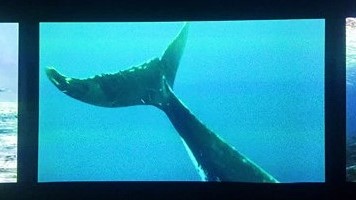Seldom do I feel belittled by an art exhibition, but Vertigo Sea is as provokingly intense as its name suggests – and one realises just how vast the ocean is.
The exhibition is modest in size; we’re given only two rooms with video installations. In the Georgian Gallery, artist John Akomfrah presents us with a vibrant, yet unsettling, soundscape as a tribute to the Russian film director Andrei Tarkovsky, accompanying scenic footage from Skye, Scotland, and Maui, Hawaii, on a single HD screen.
What is more: this screen is placed at the far end of 26 tonnes of pebbles spanning the gallery space wall-to-wall.
Titled ‘At the Graveside of Tarkovsky’, this installation is overwhelmingly multisensory. You, the viewer, feel and hear the crunching of pebbles beneath your feet as you stare at a slideshow of dramatic landscape footage. You manoeuvre a monolithic, cuboidal plaster slab obstructing the view as it protrudes from the pebbles like a colossal and unforgiving effigy.
Accompanied by the rich soundscape, you’re transported to an alternate dimension, on a beach far from the Talbot Rice’s Georgian Gallery. A place engulfed with a melancholic presence, almost too difficult to bear, as chilling sounds of grief and woeful singing reverberate around the space. It is made even more unsettling as human figures are exempt from this footage, yet omnipresent throughout the gallery soundscape. Against the cacophonous champing of stones, particularly as I stumbled around in loafers, the ambience was bursting with vivacity.
But considering the many pebbles, the sorrowful ambience, and the colossal slab of plaster, the space seems to be demarcated as less of a beach and more of a hyperbolic graveyard: a dimension to which no one may wish to be transported.
Vertigo Sea, however, throws the viewer into the farthest reaches of the ocean, exploring the many ruthless and unforgiving ways this merciless domain has served as a burial ground, both physical and metaphorical, human and natural. Split across three screens, Akomfrah pieces together footage of nuclear armaments being trialled, and whales being slaughtered, with incredible shots of the many natural wonders concealed beneath the surface.
A dead salmon rots on a forest floor, after which we’re lanced across fractured ice sheets and dramatic skies; Vertigo Sea really does chronicle the brutality of the ocean, denoting how humans, as well as the very creatures that inhabit the seas and the surrounding geography, are all equally dominated by such a great and pervasive expanse of blue.
Akomfrah also underscores the entirety of the installation with a powerful, historical charge of colonialism and cultural identities dispersed by the ocean; he brings in undertones of the sea serving as a cemetery to those who succumbed to Pinochet’s rule, to the Algerian Revolution, to the Vietnam War, and even to today’s migrant crisis.
A subdued pity is granted to the many cadavers swallowed by the lapping and babbling of the waves, but to the 50,000 whales, too, that lost against the whaler’s harpoon – all thrown into this whirling vortex of crashing, bubbling and gargling.
We are given some solace, however. The installation, as split between three screens, allows the viewer to avert their gaze when one item of footage is particularly challenging to watch – for me, the slicing of a freshly-harpooned whale corpse; for others, the detonation of explosives. But this video triptych also serves to engulf the viewer, really demonstrating the inescapability of the ocean, as Vertigo Sea’s disjunct panoramic proclaims all that is wrong with humanity, with all that is mesmerising about the ocean.
Vertigo Sea is a difficult installation to sit through, and perhaps to never endure again, but its intensity undoubtedly does warrant a visit.
Talbot Rice Gallery
Until 27 January 2018
Photo credit: Carlos Finlay

